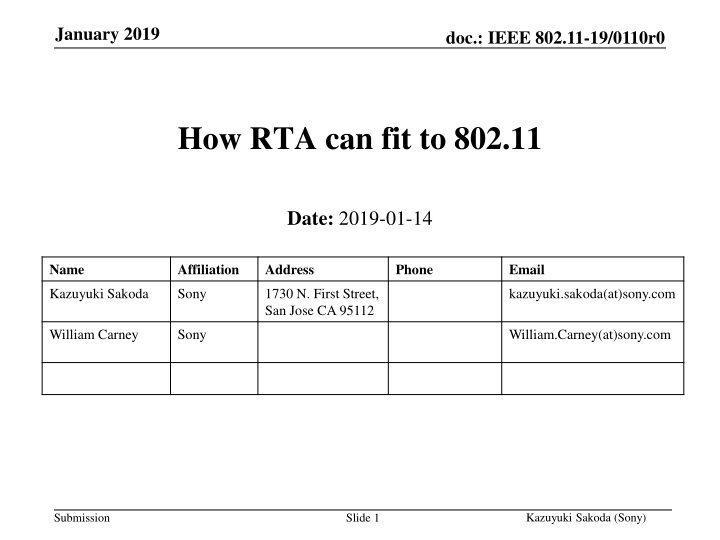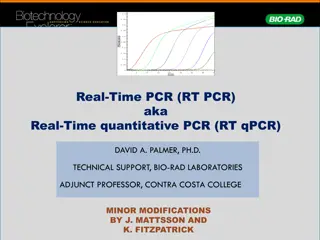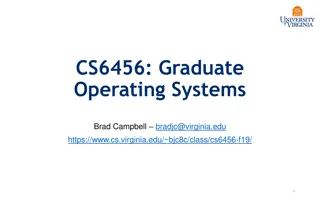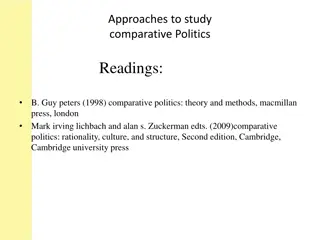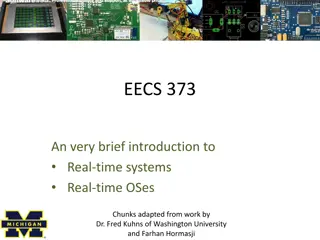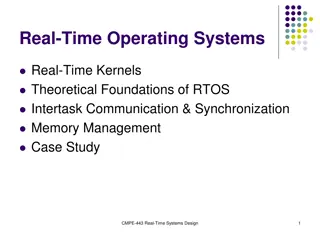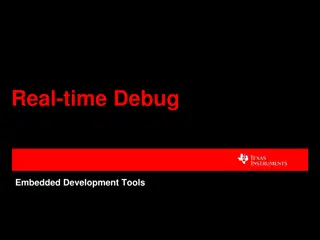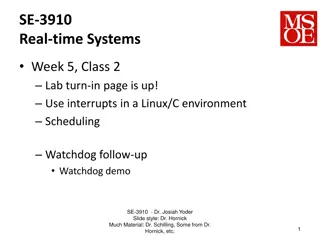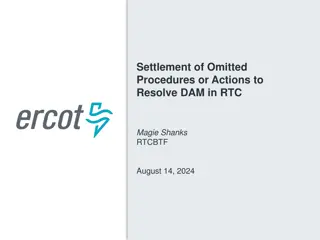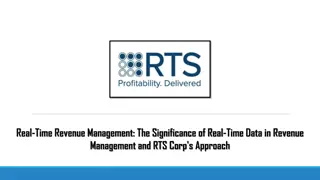Proposed Real-Time Technology Approaches
In this submission, Kazuyuki Sakoda from Sony addresses the integration of real-time technology with IEEE 802.11 standards. The discussion revolves around aligning the technology with 802.1 TSN, potential APIs, TSN compatibility, additional API considerations, and contrasting approaches in the development of real-time capabilities within the standard. The presentation outlines the benefits and challenges of defining real-time technology as a standalone project, highlighting its implications and potential limitations. By evaluating various strategies, the document aims to explore how real-time capabilities can enhance the 802.11 standard.
Download Presentation

Please find below an Image/Link to download the presentation.
The content on the website is provided AS IS for your information and personal use only. It may not be sold, licensed, or shared on other websites without obtaining consent from the author.If you encounter any issues during the download, it is possible that the publisher has removed the file from their server.
You are allowed to download the files provided on this website for personal or commercial use, subject to the condition that they are used lawfully. All files are the property of their respective owners.
The content on the website is provided AS IS for your information and personal use only. It may not be sold, licensed, or shared on other websites without obtaining consent from the author.
E N D
Presentation Transcript
January 2019 doc.: IEEE 802.11-19/0110r0 How RTA can fit to 802.11 Date: 2019-01-14 Name Affiliation Address Phone Email Kazuyuki Sakoda Sony 1730 N. First Street, San Jose CA 95112 kazuyuki.sakoda(at)sony.com William Carney Sony William.Carney(at)sony.com Kazuyuki Sakoda (Sony) Submission Slide 1
January 2019 doc.: IEEE 802.11-19/0110r0 Introduction RTA TIG studied applications requiring low latency capability As presented in [1], it is desirable that this 802.11 amendment should define a technology that is aligned with 802.1 TSN Some additional APIs might be useful, particularly for 802.11 networks as discussed in [2] In parallel, we see that EHT TIG/SG is also trying to embrace low latency capability as a part of the project scope [3] It would be useful to have some discussion regarding the possible approaches for 802.11 to define real time technology as a part of the 802.11 standard Kazuyuki Sakoda (Sony) Submission Slide 2
January 2019 doc.: IEEE 802.11-19/0110r0 Recap : TSN compatibility What is suggested by [1]: 802.11 should define compatible features with 802.1 TSN, such as Time-Aware Traffic Shaping This type of technology should be PHY/Lower MAC independent RTA technology coverage: Higher Layer 802.1 Network Higher MAC RTA MLME 802.11 MAC SME Lower MAC PHY PLME 802.11 PHY Kazuyuki Sakoda (Sony) Submission Slide 3
January 2019 doc.: IEEE 802.11-19/0110r0 Recap : Additional API? If we add additional API similar to TSPEC [4], RTA technology coverage: Higher Layer 802.1 Network Higher MAC RTA MLME 802.11 MAC SME Lower MAC PHY PLME 802.11 PHY Kazuyuki Sakoda (Sony) Submission Slide 4
January 2019 doc.: IEEE 802.11-19/0110r0 Recap: EHT discussion EHT might be developing real-time technology [3] However, draft PAR proposal [5] does not include real time capability in its scope RTA technology coverage: Higher Layer 802.1 Network Higher MAC MLME 802.11 MAC SME RTA?? Lower MAC PHY PLME 802.11 PHY Kazuyuki Sakoda (Sony) Submission Slide 5
January 2019 doc.: IEEE 802.11-19/0110r0 Different approaches potentially exist to achieve similar outcomes regarding RTA Review and discuss the alternatives Kazuyuki Sakoda (Sony) Submission Slide 6
January 2019 doc.: IEEE 802.11-19/0110r0 Define real-time technology solely If RTA becomes solo project: Pros: We can secure real-time capability in the specification The solution could/should be band agnostic Cons: The coverage of the technology might be limited in some way, i.e., try to reuse existing components; not requiring hardware changes May not deliver best possible latency improvements if not tightly coupled to specific MAC/PHY 802.1 Network Higher MAC RTA MLME SME Lower MAC PHY PLME Kazuyuki Sakoda (Sony) Submission Slide 7
January 2019 doc.: IEEE 802.11-19/0110r0 Let EHT work on everything If it is decided to have EHT work on real time technology Pros: We can modify Lower MAC and PHY as needed Cons: Not clear if EHT will put emphasis on real time capability The solution will be operating band specific Higher Layer 802.1 Network Higher MAC MLME EHT 802.11 MAC SME Lower MAC Real-time feature?? PHY PLME 802.11 PHY Kazuyuki Sakoda (Sony) Submission Slide 8
January 2019 doc.: IEEE 802.11-19/0110r0 A more advanced option We should be able to leverage both RTA focused project deliverable and EHT deliverable Pros: Real time technology could be defined as band agnostic framework We can leverage advanced lower MAC and PHY features if EHT defines such capability Cons: Careful RTA/EHT project coordination will be necessary 802.1 Network Higher MAC RTA MLME SME Lower MAC EHT Real-time Feature ?? PHY PLME Kazuyuki Sakoda (Sony) Submission Slide 9
January 2019 Or more challenging goal might help grow the community doc.: IEEE 802.11-19/0110r0 If we truly believe that there is a strong need to satisfy challenging low-latency and robustness requirements, it might be better to forget everything about 802.11 backward compatibility Pros: Maybe possible to design truly optimized specification Cons: Could be hard to obtain support on this direction from 802.11 community 802.1 Network Higher MAC MLME SME Lower MAC RTA: Brand new 802.11 PHY PLME Kazuyuki Sakoda (Sony) Submission Slide 10
January 2019 doc.: IEEE 802.11-19/0110r0 Summary Walked through some options for 802.11 to develop real-time technology RTA TIG may want to discuss as a group which option would be beneficial to the community while maintaining reasonable/viable project scope Kazuyuki Sakoda (Sony) Submission Slide 11
January 2019 doc.: IEEE 802.11-19/0110r0 Straw poll (1) Which option do you think that 802.11 should take? RTA defines whole real time functionality (forget about EHT) Let EHT work on the real time capability and do nothing else RTA defines higher MAC/MLME/SME functionality, whereas soliciting EHT to work on real time lower MAC/PHY technology Define a whole new MAC/PHY spec from scratch Need more discussion: Kazuyuki Sakoda (Sony) Submission Slide 12
January 2019 doc.: IEEE 802.11-19/0110r0 References [1] IEEE 802.11-18/1542r2, Time-Aware Traffic Shaping over 802.11, Dave Cavalcanti, et.al. [2] IEEE 802.11-18/1972r7, Thoughts on RTA development, Kazuyuki Sakoda, et.al. [3] IEEE 802.11-18/1263r3, EHT SG formation Motion, Ron Porat, et.al. [4] Draft P802.11REVmd D2.0 [5] IEEE 802.11-18/1231r1, EHT draft proposed PAR, Laurent Cariou Kazuyuki Sakoda (Sony) Submission Slide 13
